Chest Tube Management – Flashcards
Unlock all answers in this set
Unlock answersquestion
What is the purpose of a chest tube? - what do they aid in? - What do they reestablish?
answer
- Removal of air or fluid from the pleural space - they aid in expansion of the lung as the air or fluid exists - Reestablish negative pressure in the pleural space
question
Why is negative Intrapleural pressure needed?
answer
- needed to keep the lung inflated
question
Where would a chest tube need to be placed if its purpose was to drain free air?
answer
- air in the pleural space rises, so it would be placed above the 2nd intercostal space
question
If a chest tube needed to drain pleural fluid where would it be placed?
answer
- the fluid gravitaties to the most dependent point - Place the chest tube in the 4th - 5th intercostal space usually midaxillary line
question
What do Mediastinal tubes drain and where are they placed?
answer
- They drain the pericardium are after open heart surgery and are placed in the mediastinal area
question
When are chest tubes needed?
answer
- After any lung resection surgery or cardiac surgery (except a total removal of a lung) - After any injury to the lung causing excessive fluid in the pleural space. This can include blood, pus, serous drainage, and lymph
question
Pneumothorax - what is it? - What does the loss of negative pressure cause - when will pain occur?
answer
- Air in the pleural space - causes the lung to collapse - pain will occur as the atmospheric air irritates the parietal pleura
question
How can a Spontaneous pneumothorax occur?
answer
- without surgery or trauma
question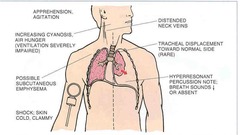
Tension Pneumothorax - what is it and what might it cause?

answer
- Air continues to cause increasing pressure and decreasing lung expansion. - This can cause a mediastinal shift of the heart and great vessels and can cause cardiac arrest.
question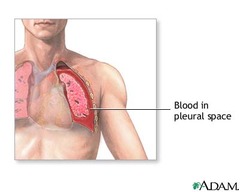
Hemothorax - What is it and What can it be caused by?

answer
- Bleeding in the pleural space - due to trauma or surgery
question
Chylothorax - What is it?
answer
- A fluid consisting of a mixture of lymphatic drainage and chylomicrons that has a milky appearance.
question
What are Chylomicrons?
answer
Chylomicrons are small fat globules composed of protein and lipid (fat) which are combined in the lining of the intestine.
question
Chylomicrons - where are they found and what do they serve to transport?
answer
- Chylomicrons are found in the blood and lymphatic fluid - where they serve to transport fat from its port of entry in the intestine to the liver and adipose tissue
question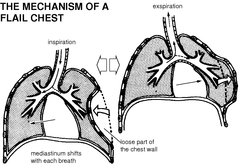
Flail Chest - What does it result from?

answer
- Results from trauma yielding multiple rib fractures and instability of the chest wall
question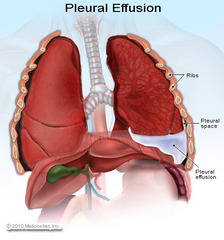
Pleural Effusion - What is it and when can it occur?

answer
- An abnormal fluid collection of the pleural space - can occur with heart failure, surgery or malignancy
question
Effects of a Collapsed Lung - when does inspiration occur - what does a leak in the intrapleural space create? - How is normal intrapleural pressures re-established?
answer
-Normally inspiration occurs when the increased negative pressure pulls the lungs against the enlarged chest cavity expanding the size - positive instead on negative pressure that causes the lung to collapse - Chest tubes
question
What are the normal lung pressures upon inhalation and exhalation?
answer
- Inhalation negative 8 cm H20 - exhalation negative 4 cm H2O
question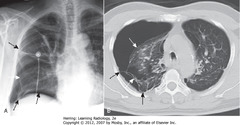
Pleural Space - where is it - how big is it and what does it contain?

answer
- Is the space between the inner and outer lining of the lung. - It is normally very thin, and lined only with a very small amount of fluid
question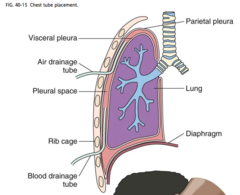
Hemothorax - where would the chest tube be placed

answer
- insertion site would be at the 3rd to 6th intercostal space in the mid axillary area in order to drain the fluid
question
Placement of the chest tube - who places it? - what are the other important things to keep in mind?
answer
• A physician will place the chest tube. It may be placed during surgery or after trauma • A sterile tray and a variety of sizes of chest tubes will need to be available • You will need to set up a chest tube drainage system. There is a wide variety on the market. • You will need wall suction set up if suction is ordered. • Sterile water will need to be added to fill the water seal chamber to the 2CM line • If suction is ordered remove the cap on the suction control chamber to open the air vent and instill sterile water until it reaches the 2CM line and recap • Keep the drainage tube tip sterile and connect it to the chest tube the MD inserted. • Tape all connections • Turn on suction to gentle bubbling • Position and secure tubing so that there are no dependent loops
question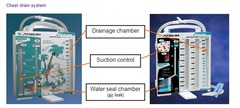
Chest tube drainage systems

answer
- is a closed drainage set up
question
Collection Chamber - what does it do?
answer
- This will collect drainage from the chest. - This is calibrated and has a surface for recording output from the system for each shift
question
Water Seal Chamber - where is it? - what is its main purpose? - When is the water seal established? - What do you have to watch for and what position should the system be in?
answer
- This is the middle chamber of a chest drainage system. - The main purpose of the water seal is to allow air to exit from the pleural space on exhalation and prevent air from entering the pleural cavity on inhalation.. - When the water seal chamber is filled with sterile fluid to the 2cm line. - Watch for evaporation and keep the chest drainage unit upright to maintain the seal.
question
What does bubbling in the water on a Water seal chamber indicate? - how is the degree of the leak indicated
answer
- Air leak - Indicated by the amount of bubbling on the meter
question
What does the Water Seal include to measure the pressure of the pleural cavity?
answer
A calibrated manometer
question
What should you see in the small arm of the water seal if there is no air leak? - What is this movement called and what is it an indicator of?
answer
-If there is no air leak the water level should rise and fall with the client's respirations, indicating normal pressure changes. - tidaling and is one indicator of a patent pleural chest tube
question
What is the purpose of the high negativity float valve at the top of the water seal chamber?
answer
- This acts as a safety feature in the event of high negative pressure
question
What are three situations that can cause high negative pressure?
answer
- Client in respiratory distress, coughing or crying - Chest tube stripping - Decreasing or disconnecting the suction
question
Suction control chamber - what can it be?
answer
- wet or dry
question
Wet Suction Control Chamber - where is it located - What limits the amount of suction transmitted to the pleural space?
answer
- Located on the left side of the unit - The height of the water not the suction source
question
Wet Suction Control Chamber - what is the recommended suction pressure? - When might a lower setting be needed?
answer
- (-20cm) - for infants or adults with compromised lung tissue
question
Wet Suction System - What does increasing the suction of the wall regulator do? - What can excessive wall suction regulation cause
answer
- increases airflow though the system, but will have minimal effect on the amount of suction in the chest cavity. - will cause excessive bubbling which can disturb clients and cause fluid evaporation.
question
Dry Suction System - what can these systems provide? ;; 2 things
answer
- can provide for higher suction pressure levels, - there is no continuous bubbling resulting in quiet operation
question
Dry Suction Systems - what are they controlled by? - What can suction be set at? - what is suction usually preset at? - what type of clients can benefit from this type of system?
answer
- by a self-compensating regulator. - Suction can be set with a dial at -10, -15, -20,- 30, or -40. - It is usually preset at -20 - Clients requiring higher suction settings
question
Taping connections
answer
- Important to tape the connection between the chest tube coming from the patient and the drainage tube very securely. The connector needs to be securely taped.
question
Initiation of chest tube management - Antibiotics
answer
- Are given within 30 minutes prior to insertion of the tube and repeated in 8 hours
question
Initiation of chest tube management - Suction ;; what is suction initially set at? ;; when must the water level in the suction chamber be monitored? ;; what do you do if it evaporates?
answer
- 20 CM of water suctioning - daily and kept at the appropriate levels - Sterile fluid should be added
question
When will patients be placed on water seal ?
answer
- prior to chest tube removal, assuming certain conditions are met
question
What are the conditions that need to be met in order for chest tubes to be removed?
answer
- Chest x-ray taken to document lung expansion - Patient is placed on water seal for 24 hours prior to removal of chest tube - Chest x-ray will be taken before removal of tube from the chest.
question
Hazards of Chest Tubes - what are the 5 main ones?
answer
- During insertion trauma to lung or other cardiac/vascular structure - Clamping the tube when air is till leaking into the lungs this can cause a tension pneumothorax - Infection - Stripping tubes can cause trauma to lung tissues. possibly causing clots to occur - If the drainage system becomes dislodged a re-occurrence of the pneumothorax may result.
question
What should the nurse do if clots are noted in the chest tube?
answer
gently milking or draining the drainage into the collection chamber will assist in proper functioning of the system.
question
Care of the Client with Chest Tubes - Assessment ;; what are the seven main things to look at?
answer
-Cardiac - Respiratory ;; Respiratory rate ;; Auscultation ;; Watch for signs of respiratory distress - Signs of infection - Subcutaneous emphysema - Assess for proper working of the chest tube system - Drainage, amount and color important. Larger amount immediately after surgery with a color of serosangiouness that should decrease and change in color the serosangiunous. - Check chest tube dressing.
question
Care of the Client with Chest Tubes - Patient Teaching ;; what are the 3 main things that you want to teach the patient/ family
answer
- Purpose of the system and how to get along with the system in place. - Explain routine nursing care of the system and what observations will be done - Safety precautions ;;;;Do not have the chest tube drainage system high, it should stay below the clients lung level. ;;;; don't tip it on its side
question
Care of the Client with Chest Tubes - importance of ambulation
answer
- Important to keep lungs in best possible condition - Protect against dislodgement of the tube
question
Care of the drainage system - what are things that the nurse needs to do?
answer
• Tape all connections • Place unit on floor or on bedside rack in a safe place • Never lift above the chest • Refill water levels PRN • Replace setup when drainage amount requires changing out drainage system >>>Have another nurse assist you so this is done quickly • Do not clamp unless the system is accidentally opened. Only clamp for short period of time. • Do not strip tubes • Keep two padded clamps at the bedside for use in emergency situations
question
Dressing Change - when are they done? - what do you check when you assess the dressing?
answer
- done according to policy and procedure - May be the first 24-48 hours and then PRN if saturated - check for clean, dry, and intact dressing
question
What is an emergency dressing?
answer
- if chest tube dislodged is a dressing taped on 3 sides and notify MD
question
What are the conditions that need to be met before the chest tube can be removed? - 3 main ones
answer
- Resolution of pneumothorax confirmed via x-ray - less than 100cc of pleural drainage in 24 hours - absence of air leak on valsalva maneuver or forceful cough
question
Before removing the chest tube what are some things that you should teach the patient? 3 things
answer
- burning sensation may occur - pre-medicate as needed - chest tube is pulled out on a deep exhalation
question
What type of dressing is put on the wound after the chest tube is pulled out?
answer
- occlusive dressing airtight dressing or vaseline gauze may be applied
question
What are some important S/S of a reoccurring pneumothorax to teach the patient? - 3 main ones
answer
- SOB - Chest pain or pain with inspiration - notify health care provider
question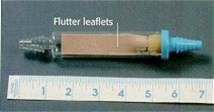
Heimlich Valve - when are they used? - what there function?

answer
- For pneumothorax only - the leaflets will let air out and will not allow air in
question
What are the 7 steps of the performance test?
answer
1. you insert 2 cm of water into the water seal chamber 2. you insert 20 cm of water into the suction chamber 3. you apply the foam block into the suction chamber 4. you tape the connection between the client's chest tube and the suction device 5. you attach the suction tube to wall suction 6. you turn on the wall suction to gentle bubbling 7. you secure the drainage device below the level of the clients chest



